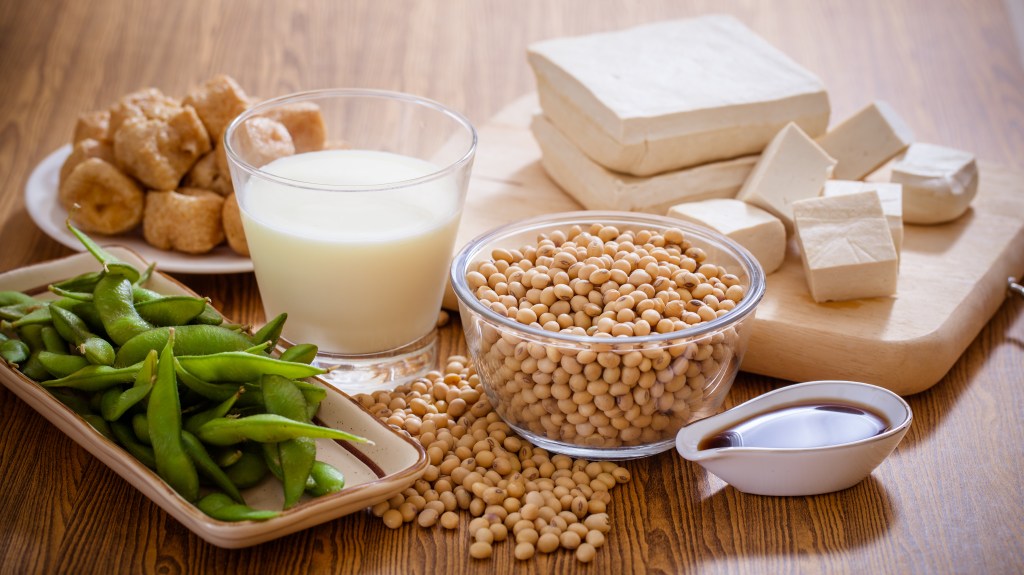At a glance
Most modern soy products are highly processed, genetically modified, and contain compounds that may interfere with hormone balance and digestion. Fermented soy options can offer a more nutritious and digestible alternative to conventional soy foods.
Soy is a common ingredient in vegetable oils found in many conventional and organic prepackaged products. But is soy bad for you?
Yes, many soy products are highly processed, sourced from genetically modified (GMO) crops, and contain phytoestrogens and antinutrients that can contribute to gut issues, liver problems, and hormonal imbalances.
Uncover the potential risks of unfermented soy and discover how it measures up against the health benefits of fermented alternatives.
What is soy?
Soy, or soybeans, are a type of legume first domesticated in China around the 11th century BC.
With hundreds of varieties, including green, yellow, black, white, and red, soybeans have been a cornerstone of traditional Asian cuisine, featuring staple dishes such as simmered soybeans and miso soup.
In addition, soybeans are rich in plant-based essential amino acids and have become a popular alternative to animal protein among vegans and vegetarians.
Soy is a highly versatile ingredient used in a wide range of commercial products, including processed snacks, plant-based meat substitutes, dairy alternatives, cooking oils, and packaged meals.
Because soy is cheap to produce, it’s widely used in ultra-processed foods, where it serves as a cost-effective filler, emulsifier, and protein source in many packaged products.
Watch the video below to discover why unfermented soy products aren’t a health-conscious choice.
Is soy bad for you?
Soy is widely marketed as a healthy food and has long been considered a nutritious legume in many Asian cultures.
However, concerns have been raised about the potential health risks of soy products, particularly due to their estrogenic properties and the fact that most soy crops are GMO.
Conventional soy foods are predominantly derived from GMO crops, which are bioengineered to withstand glyphosate, a chemical herbicide linked to cancer, reproductive issues, neurological effects, and gastrointestinal disease.
Additionally, soy products contain isoflavones, a group of plant-derived compounds that have estrogenic effects. This means isoflavones can mimic the hormone estrogen in the body, potentially affecting hormone balance and reproductive health.
Regular soy intake may trigger hormonal imbalances, potentially leading to irregular menstrual cycles in women and reduced sperm count and breast growth in men.
“Consuming too much soy can be detrimental to hormonal balance, especially in men,” explains Dr. Berg. “Soy can lead to several feminizing effects, including enlarged breasts and even lactation in severe cases.”

Potential downsides of soy
Although soy products such as soy supplements, soy protein, and soy milk are often touted as health foods, consuming soy can have several potential downsides.
Here are four health risks associated with excessive consumption of unfermented soy.
1. Digestive issues
Soy protein intake has been shown to disrupt the intestinal barrier, increase gut inflammation, and contribute to an overgrowth of harmful bacteria in the gut microbiome.
A study published in Molecules investigated the effects of soy on digestive health and concluded, “Soy glycinin induces intestinal stress, autophagic flux blockage, microbiota imbalance, and intestinal barrier damage.”1
This may explain why soy is one of the most common food allergens, especially in babies and children with underdeveloped immune and digestive systems.
2. Increased cancer risk
High estrogen levels are linked to an increased risk of hormone-responsive cancers, including ovarian, endometrial, prostate, and breast cancer.
Soy isoflavones have been shown to possibly raise estrogen levels and mimic its effects in the body, raising concern about its ability to increase the risk of estrogen-associated cancers.
It’s important to note that the impact of soy on cancer development remains a topic of debate. The American Cancer Society highlights that women in Asian countries with soy-rich diets tend to have a lower breast cancer risk.2
However, this may be attributed to a diet richer in whole foods and fermented soy products, compared to Western diets, which rely more heavily on unfermented and ultra-processed soy products.

3. Thyroid dysfunction
Though more research is needed, there are indications that soy can disrupt thyroid hormone production, particularly in those with reduced thyroid function or inadequate iodine intake.
Additionally, soy has been shown to interfere with hypothyroid medication, which can significantly impact thyroid hormone balance.
A study published in Thyroid found that soy inhibits the absorption of the thyroid hormone medicine levothyroxine, reducing its effectiveness and potentially interfering with the management of thyroid disorders.3
Individuals taking hypothyroid medications should consult their healthcare provider to determine whether consuming soy is safe and compatible with their treatment plan.
4. Poor liver health
Highly refined soy foods are typically processed using hexane, a petroleum product derived from crude oil.
Hexane is a solvent used to extract oils and fats from soybeans to create products such as soy protein isolates, soy protein concentrate, soybean oil, and soy flour.
Frequent exposure to hexane, even in small amounts, can be hazardous and has been linked to neurotoxic effects, liver damage, and an increased risk of liver cancer.

Fermented vs. unfermented soy
Unfermented soy products can increase glyphosate exposure, trigger hormonal imbalances, and inhibit optimal thyroid and liver function.
Despite the downsides associated with unfermented soy, fermented soy foods, which are typically fermented using beneficial microbes such as Rhizopus oligosporus or Bacillus subtilis var. natto, have been consumed for millennia.
Fermented soy products, such as tempeh, natto, and miso, are easier to digest than unfermented soy, thanks to beneficial microbes that break down antinutrients in raw soybeans during the fermentation process.
This can lead to fewer gastrointestinal issues commonly associated with soy consumption, including abdominal pain, diarrhea, and gas.
Fermentation also increases the bioavailability of nutrients such as copper, iron, magnesium, and manganese, which explains why fermented soy is significantly more nutritious.
In addition, unfermented soy products lack the beneficial microbes found in fermented versions, which means they retain enzyme inhibitors. These inhibitors can interfere with protein digestion and absorption by blocking the activity of digestive enzymes.
Unfermented soy also contains phytic acid, which blocks the absorption of minerals such as calcium, magnesium, iron, and zinc in the small intestine.
A diet high in unfermented soy may contribute to trace mineral deficiencies and associated health issues, including fatigue, muscle aches, heart palpitations, slow wound healing, and decreased immune functions.

Common foods that contain soy
Though soy is primarily associated with Asian cuisine, millions of global food products, including minimally processed and ultra-processed foods, contain soy.
Unfermented soy foods include:
- Edamame
- Soybeans
- Soy nuts
- Soy sauce
- Tofu
Keep in mind that while some soy sauces are fermented using the traditional koji and moromi methods, most are produced chemically through acid hydrolysis, which leaves the soy’s anti-nutrient compounds intact.
Fermented soy foods include:
- Tempeh
- Miso
- Natto

Soy is also added to processed foods and listed under several names, including soy protein isolate, glycine max, soybean oil, textured vegetable protein (TVP), soya bean, and hydrolyzed vegetable protein (HVP).
Common processed foods that contain soy include:
- Protein bars and powders
- Breakfast cereals
- Diet foods and TV dinners
- Weight loss shakes
- Fast food and restaurant food
- Prepackaged foods
- Plant-based milk
- Low-fat milk products
- Plant-based meat alternatives
- Vegetable oils
- Condiments and salad dressings
- Canned foods
- Hummus, dips, and spreads
- Soy infant formula
Those looking to eliminate soy from their diets should carefully check ingredient lists to avoid hidden sources of soy. In addition, following a nutritious, whole-foods-based diet can also help limit processed foods and soy intake.
Key takeaways
- Is soy bad for you? Yes, many soy products are highly processed and contain inflammatory proteins, antinutrients, and phytoestrogens that may disrupt hormones, hinder mineral absorption, and affect thyroid and digestive health.
- Soy is commonly added to many processed foods, often listed under names such as soy protein isolate, soybean oil, or hydrolyzed vegetable protein, making label awareness essential for avoiding hidden sources.
- Fermented soy products such as natto, miso, and tempeh contain reduced levels of antinutrients, offer beneficial probiotics that support gut health, and may be safer and more nutritious than unfermented soy.
FAQ
1. Is soy bad for you?
Yes, there are several adverse effects of soy, including soy milk and soy protein isolate. Most soy products are ultra-processed and derived from genetically modified (GMO) crops that have been linked to health risks.
In addition, soy contains phytoestrogens and inflammatory proteins that have been linked to leaky gut, food allergies, cardiovascular disease, hormonal imbalance, reproductive issues, and an increased risk of hormone-sensitive cancers.
2. Does soy actually increase estrogen?
Yes, soy may increase estrogen levels in men and women when consumed excessively. Though more research is needed, it has been shown that soy isoflavones can bind to estrogen receptors and mimic the effects of estrogen.
3. Why do men avoid eating soy foods?
Many men avoid soy products, like soy milk, due to their high phytoestrogen content, which can mimic estrogen’s effect on the body.
When consumed in excess, soy isoflavones may reduce sperm count and lead to an increased risk of prostate cancer and gynecomastia, also known as abnormal breast growth, in men.
4. Does soy cause inflammation?
Yes, soy contains inflammatory proteins that have been linked to chronic inflammation, especially in the gut. Eating soy protein can trigger an immune response, which is particularly common in young children with underdeveloped digestive systems and poor immune system functions.
5. Is soy bad for your gut?
Yes, unfermented soy is primarily GMO and treated with glyphosate, an herbicide linked to digestive disorders. Soy also contains inflammatory proteins and antinutrients, which can increase the risk of gut irritation and poor mineral absorption.
However, fermented soy products such as tempeh and natto contain live cultures that break down inflammatory compounds, making them easier to digest and potentially reducing inflammation, gas, bloating, and sensitivities.
6. Can I have soy foods on keto?
Yes, soy products are technically keto-friendly as they’re low in carbohydrates. However, most processed and unfermented soy products aren’t suitable for those following a Healthy Keto® diet due to their high concentrations of antinutrients, inflammatory proteins, and phytoestrogens.
7. Is natto good for you?
Yes, natto is widely regarded as a healthy food. Natto is a minimally processed, fermented soy product that improves soy’s digestibility and increases the bioavailability of protein, vitamins, and minerals while also providing beneficial probiotics for gut health.
Sources
- https://pmc.ncbi.nlm.nih.gov/articles/PMC10534728/ ?
- https://www.cancer.org/cancer/types/breast-cancer/risk-and-prevention/factors-with-unclear-effects-on-breast-cancer-risk.html ?
- https://pubmed.ncbi.nlm.nih.gov/16571087/ ?








